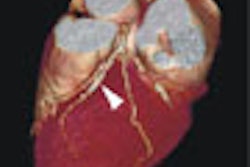VIENNA - There are conflicting reports regarding the radiation doses delivered by 64-slice CT and dual-source CT -- especially concerning an increasingly common application with a worrisome dose profile: retrospectively gated coronary CT angiography (CTA).
At the 2008 European Congress of Radiology (ECR) on Saturday, researchers from China presented a study that examined the two modalities in two groups of patients undergoing coronary CTA, and found that any dose difference depends on the patient's heart rate.
Another presentation detailed dose study results using data from the multicenter CORE 64 trial of 64-slice coronary CTA, using patient data to create phantom models.
Dual-source CT versus 64-slice
Researchers from Beijing and Jinan, China, examined 40 patients undergoing coronary CTA on a 64-slice scanner (Sensation 64, Siemens Medical Solutions, Malvern, PA) and 20 similar patients who were scanned on a dual-source CT scanner (Somatom Definition, Siemens).
"Three cardiac radiologists assessed and compared the ... images independently," rating them on a scale from 5 (excellent) to 1 (nondiagnostic)," said Weichang Qin from Shandong Imaging Research Institute in Jinan. "Estimations of radiation dose were based on dose-length product."
The 64-slice acquisitions were performed at 120 kVp and 770 mAs, and the dual-source scanner was set at 120 kVp and 550 mAs, he said. While the pitch of the dual-source scanner was adapted to the higher heart rates and ranged from 0.2 to 0.5, the pitch of the 64-slice scanner was fixed at 0.2.
The results showed that doses were essentially equivalent at lower heart rates, but dual-source CT had the edge in higher doses.
The average estimated effective dose of 64-slice CT was 11.7 ± 0.27 mSv for low heart rates (50-70 bpm). "There were no higher heart rates (data) and fixed pitch for the 64-slice scanner due to limited temporal resolution," Qin said.
At low heart rates, the dose was insignificantly higher for the dual-source scans (12.2 ± 1.73 mSv), but with this modality the dose dropped as heart rates rose: 9.46 ± 0.92 mSv at 60-70 bpm, 7.98 ± 1.59 mSv at 80-90 bpm, and 5.94 ± 1.25 mSv at heart rates higher than 90 bpm.
"The quality of (dual-source) images at heart rates above 70 bpm is equivalent to that of heart rates below 70 bpm, without a decrease in image quality," Qin said. "The radiation dose of (dual-source CT) is not different from that of 64-slice CT at low heart rates, but (the) dual-source CT dose is lower at high heart rates," he concluded.
64-slice coronary CTA dose in a multicenter study
Another ECR presentation examined coronary CTA dose data from the nine-center European CORE 64 trial. More than 350 patients were scanned on 64-slice CT scanners (Aquilion 64, Toshiba Medical Systems, Tokyo).
The original study varied the acquisition protocol by patient size and gender, measuring the weighted CT dose index (CTDIw) on all the scanners. For the ancillary dose study, the scanner characteristics were modeled in a Monte Carlo algorithm (EGS4).
In the CORE 64 trial, "the helical scan parameters were adapted according to gender and patient size, explained Dr. Jacob Geleijns from the Leiden University Medical Center in Leiden, Netherlands. "We selected three female patients -- a thin, a normal, and an obese patient -- and also three male patients: thin, normal, and obese. We used the Monte Carlo algorithm to do a dose assessment from this group of patients."
The phantoms were created by segmenting air, lung, bone, and muscle data based on Hounsfield units; Monte Carlo calculations were then applied to the segmented voxel phantoms to assess organ and effective dose in all six patient models, Geleijns said. The doses were measured for the complete exam protocol in the original study, including CT radiography, calcium scoring, dynamic bolus tracking, and coronary CTA, acquired at 64 x 0.5 mm and 240-400 mAs.
The results showed small differences for CTDIw (8.6 ± 0.5 mGy/100 mAs) in the models. The overall effective doses for the multiple exam protocol in the six voxel phantoms was 17 ± 2 mSv, with variations attributable to patient size but not gender. The overall effective dose for ECG-gated coronary CTA was 15 ± 2 mSv. The organs contributing most to the effective dose were lung, stomach, and breast, Geleijns said.
The Monte Carlo algorithm allowed the researchers to define a realistic acquisition geometry for cardiac CTA, yielding effective doses comparable to other studies. However, the model did not function perfectly, Geleijns said. Some organ doses showed deviations up to a factor of two compared to comparable exams reported in the medical literature.
By Eric Barnes
AuntMinnie.com staff writer
March 8, 2008
Related Reading
AAPM offers report on CT radiation reduction, February 19, 2008
Pediatric CT dose drops with breast shields plus tube modulation, February 26, 2008
Pulmonary CTA packs a radiation punch to female breasts, November 24, 2005
Coronary CTA study aims for lowest dose, January 11, 2008
Radiation dose slashed in 64-slice coronary CTA, February 15, 2007
Copyright © 2008 AuntMinnie.com










